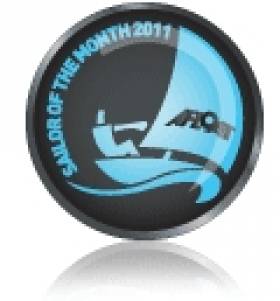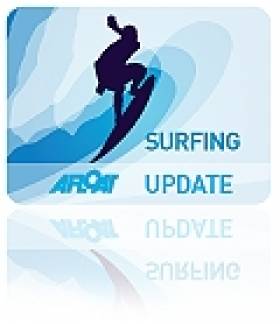Displaying items by tag: Noelle Doran
Mayo's Noelle Doran is December's Sailor of the Month
#SAILOROFTHEMONTH – Noelle Doran of Mayo is the latest Afloat.ie/Irish Independent "Sailor of the Month" in recognition of her December achievement in being the fastest woman in the world in 2011.
Her sustained speed of 36.88 knots along 500 metres of the Dungarvan speed strip in West Waterford gave her a ranking of sixth in the world against established records, while the fastest in the world, Britain's Zoe Davis and Belgium's Marie-Paula Geldhof, failed to shine in 2011, with Davis recording 35.31.
Doran also achieved a top peak speed of 38.17 knots. These performances are all recorded by GPS – in fact, precise analysis would be a massive logistical problem without GPS. Although Ireland is supposed to be a breezy country, the arrival of perfect wind conditions is difficult to predict more than an hour or so ahead, so the speed merchants have to be ready and waiting in the right place at very short notice.
Mayo may be one of Ireland's windiest counties - as recent experience has forcefully emphasized - but it lacks a perfect strip of flat water. Dungarvan can provide the water, but the wind doesn't always arrive to order, as was painfully shown in November 2010 when a stage of the World Speed Series came to West Waterford, and so did everyone else except the wind.
Lovely gentle weather doesn't break records. Thus the 42 year-old Doran had to be prepared to race down to Dungarvan from Westport as the December wind pressures rose darkly in the desired pattern. Nevertheless she'd made that demanding round trip – inevitably with night travel - some three times before it all came right, and her coach and mentor, record holder Oisin van Gelderen of Skerries, encouraged her to this remarkable peak achievement.
Out there in the raw early morning and a strong sou'west to west wind in the headwaters of Dungarvan Bay, it was perfect for speed, with Doran "lit like a banshee" as van Gelderen put it – we hope he meant it as "woman of the wind". The perfection of the moment was then rounded out by the coach himself notching a personal best of 47.88 knots in a quick zap along the beach.
So while everyone else in the depths of December was wondering what they might get for Christmas, Noelle Doran already had her gift. The drawback about such an achievement is that all your personal details go public. We now know her age, and her height too. She's just 5ft 4ins, which makes her The Mighty Atom. With her board setting an impossibly large sail, she was on the edge of becoming airborne. But she hung in and cut the mustard, a mighty achievement.
Van Gelderen Claims Irish Speed Sailing Title for 2011
#WINDSURFING - Oisín van Gelderen is all but confirmed as Irish Speed Sailing Champion for the second year running.
His national record speed (44.23 knots by 5x10 second average and 43.96 knots over 500m) puts him far ahead of his nearest competition in the rankings.
But his competitive spirit would not let him rest on his laurels.
"Ever since setting that record in February, I have been trying to beat it," he said, "and we had a really good day on Thursday in Dungarvan."
Though he did not beat his averages, he did set a new Irish record for peak speed at 47.89 knots (verification pending).
Van Gelderen dedicated his previous national title win to to the memory of Surfdock founder Alan Harris and Irish 500m speed record holder John Kenny, who both passed away in 2010.
Meanwhile, his Surfdock teammate Noelle Doran has taken the women's title for 2011 with a very impressive set of times for the year.
Her Irish women's peak record of 38.17 knots was complemented by third overall place for 2011 by 5x10 second average and first in the world over 500m.
"I'm so delighted for her," said Van Gelderen. "She had a nasty injury a few years ago, where she dislocated her hip while windsurfing. The resulting nerve damage put a stop to her competing in Waves and Freestyle, where she had multiple national titles."

























































